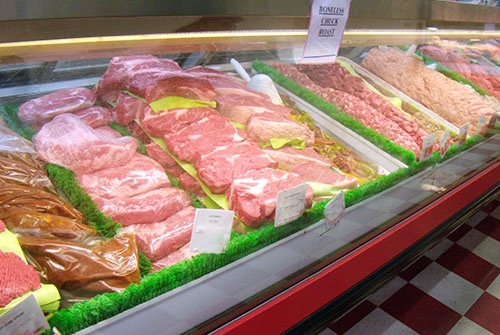Discover Fresh Cuts at Bagley Farms Meat Market Edwardsville IL for Your Following BBQ
Discover Fresh Cuts at Bagley Farms Meat Market Edwardsville IL for Your Following BBQ
Blog Article
Discover the Art of the Butcher's Cut in a Modern Meat Market
In the ever-evolving landscape of contemporary meat markets, the butcher's cut has transcended its conventional roots, merging olden workmanship with modern methods. What genuinely establishes the modern butcher apart is their ability to forge a much deeper link in between customers and the origins of their meat.
Evolution of Butchery Techniques
The evolution of butchery strategies shows an abundant tapestry of technology and adaptation driven by innovations in innovation, changes in customer need, and a deeper understanding of meat scientific research. Historically, butchery was a craft gave with generations, with approaches sharpened over centuries to take full advantage of return and taste. Nevertheless, the commercial transformation introduced mechanization, changing standard practices and making it possible for large handling.
The mid-20th century saw butchery methods further improved by clinical insights into muscle mass biology and meat aging, improving both tenderness and preference. Technologies like vacuum product packaging and refrigeration expanded item shelf-life, allowing butchers to branch out offerings and boost quality assurance. This period likewise marked the surge of customized devices, such as band saws and meat slicers, which raised accuracy and efficiency in meat handling.

Digital systems currently assist in monitoring pet provenance and optimizing cuts to meet details client choices. Additionally, a renewal in artisanal butchery has actually arised, blending typical abilities with modern-day understanding to provide to customers seeking ethical and sustainable meat alternatives.
Recognizing Meat Cuts
Understanding the complexities of meat cuts is crucial for both butchers and consumers looking for high quality and value. For butchers, exact cuts mirror skill and respect for the craft, making sure marginal waste and ideal yield.

Recognizing muscle mass make-up is vital; muscle mass used extra frequently by the pet often tend to be harder and are best matched for slow-moving food preparation techniques, while less-used muscular tissues, like those found in the loin, are a lot more tender and perfect for barbecuing or roasting. Experience with these distinctions empowers consumers to make enlightened options, boosting their culinary ventures.
Picking Quality Meat
Choosing the appropriate meat involves greater than just picking an aesthetically attractive piece from the display screen. bagley farms meat market edwardsville il. The art of selecting quality meat needs a critical eye and understanding of specific qualities that symbolize freshness and quality. Firstly, pay interest to the color; beef must have a bright, cherry-red color, while lamb ought to show a soft pink tone, and pork a pale pink. This shows the meat is fresh and hasn't been exposed to oxygen for as well long.
Secondly, take into consideration the marbling, which describes the white flecks of fat within the muscle mass. Correct marbling is a vital indication of tenderness and taste, as it melts during cooking, improving the meat's juiciness. Keep in mind, greater marbling commonly associates with premium quality cuts, such as USDA Prime.
Texture is another crucial aspect; meat should really check this site out feel solid to the touch, not slimy or overly soft. Additionally, be conscious of the scent. Fresh meat ought to have a tidy, neutral scent, devoid of any sour or off-putting smells.
Matching Cuts With Cooking Approaches

Conversely, harder cuts like brisket and chuck roast are rich in collagen, which breaks down into jelly when prepared slowly. These cuts are suitable for braising or slow roasting, allowing the meat to soften over time and establish deep, complicated flavors. Similarly, cuts such as brief ribs and pork shoulder prosper with slow-cooking methods, where expanded cooking times transform their robust appearances right into delicious dishes.
Lamb shanks and oxtail, which need prolonged food preparation to tenderize, are excellent prospects for stewing or sluggish simmering. These techniques coax out rich, hearty tastes while keeping dampness. By recognizing the distinct features of each cut, chefs and home cooks alike can elevate their cooking developments, making certain each dish is both pleasing and memorable.
The Butcher's Function Today
Navigating the evolving landscape of the modern meat market, the butcher's role today expands beyond mere prep work of cuts. Contemporary butchers are culinary craftsmens, teachers, and supporters for sustainable techniques. They link the gap in between the farm and the fork by making sure honest sourcing, recognizing pet husbandry, and focusing on transparency in the supply chain. This change shows the expanding customer demand for top quality over amount, where provenance and animal welfare are vital.
In enhancement to crafting exact cuts, butchers now engage directly with consumers, using cooking advice and tailoring selections to suit individual needs and choices. Their experience in meat aging, marbling, and flavor profiles equips consumers to make informed choices, enhancing their cooking experiences. This personalized service exhibits the butcher's developing Go Here function as a trusted consultant in the kitchen area.
Furthermore, butchers are crucial site in decreasing waste, using entire animals to produce diverse items such as sausages and supplies. This detailed technique not just respects the pet however also aligns with contemporary sustainability objectives. By doing this, the modern-day butcher personifies both tradition and advancement, adapting to an ever-changing market while preserving the artistry and honesty of their craft.
Final Thought
Proficiency in recognizing varied meat cuts and quality indications encourages butchers to give enlightened suggestions, straightening details cuts with ideal food preparation methods. By honoring historical techniques while welcoming modern needs, the butcher's role remains crucial in today's innovative meat market.
Report this page